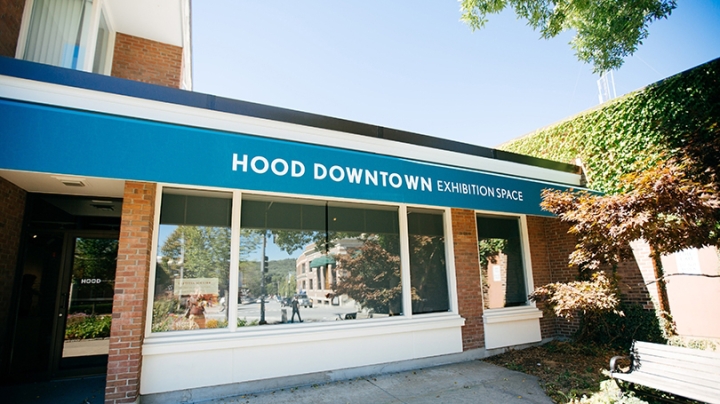The grand opening of the Hood Downtown Exhibition Space will feature The Fractal Architectures, an exhibit by French artist Laetitia Soulier, on Friday, Sept. 16.
The Fractal Architectures is the first in a 10-exhibition series that the Hood is organizing over the next couple of years while the museum itself undergoes a major renovation and expansion.
“I think of Hood Downtown as a gift to the community—a thank you for being patient while we do this big project,” says John Stomberg, the Virginia Rice Kelsey 1961s Director of the Hood.
Earlier on Friday, in its Arts and Innovation District, Dartmouth will celebrate the start of the 2016-2017 academic year and the upcoming Hopkins Center for the Arts season with three dance performances by pioneering dance troupe Bandaloop suspended by cables on—yes, on—the façade of the Black Family Visual Arts Center.
Founded in 1991, the San Francisco-based Bandaloop has performed vertical acrobatics around the world, from the historic Golconda Fort in Hyderabad, India, to the Grand Cathedral in Puebla, Mexico—and, in 2004, to the arches of Dartmouth’s own Hopkins Center and the lobby of the Fairchild Physical Sciences Center. The 4:30, 5:30, and 6:30 p.m. performances on Sept. 16 are free and open to the public. People can watch the dancers from the safe footing of the Maffei Arts Plaza.
At 7 p.m., Hood Downtown—located on Main Street between Molly’s Restaurant and the Nugget Theater—will host a wine and cheese reception for Soulier. The public will have a chance to meet the artist and explore her work.
All of Hood Downtown’s exhibitions, set to run in succession through the reopening of the museum in early 2019, will showcase contemporary artists from around the world. “You will find us showing art from different countries and different media,” Stomberg says. “We’re consciously showing painting, photography, videos, sculpture, and installations. We’re showing men and women, artists from the Africa, from Asia, from Europe, the United States, and Latin America.”
The idea, he says, is to present a “global snapshot” of this moment in contemporary art, when artists are concerned with their local identities and with global issues, from climate change to the advent of big data to globalization itself.
Stomberg says the exhibitions are key to the Hood’s goal of continuing its educational and community mission during the construction period. “We imagine classes from literary criticism to philosophy to photography to math” to visit and engage with the exhibitions, he says—as well as K-12 classes from throughout the region, and the general public. The exhibitions will be “visually stunning—literally arresting. Because we want people walking down the street to say, ‘I want to see that.’ ”
The Fractal Architectures may well have that effect. In lush reds and greens, Soulier’s photographs blur boundaries between the fantastic and the rational, depicting intricate models the artist has built by hand to meticulous scale according to the logic of theoretically infinite fractal patterns.
“Models are conceptually very interesting, because they are not a thing in and of themselves,” says Stomberg, who is curating the show. “They’re always about something else, and not about themselves.”
“My work plays with the idea of photographic images as a construct,” Soulier told Stomberg in an interview that will appear in the exhibition catalog. “Photography transforms our perception of the world around us. Through photography, we project a vision as much as we record reality. I create from that zone of indiscernibility, where ideas and physical reality meet.”
Embedded in these images is a sense of wonder and play, Stomberg says. “You have this super-logic of a fractal pattern that establishes the scale of the space—but the narrative is pure fantasy. So it’s a perfectly rational space, but what’s going on in there is anything but rational. It’s kind of like dream logic, like Alice in Wonderland.”
“My work is inspired by children’s play,” Soulier says. “In a sense, all art is a serious form of play through which we create new maps and ways of being.”
In addition to photographs, the exhibition will include an installation of a full model of the world the images depict. “These aren’t the actual models that she photographed,” says Stomberg. The original models needed to be open, like stage sets, to allow lights and cameras to approach the scenes from different angles. The installation shows the world of the photographs imagined in three dimensions—complete with view holes for visitors to peek inside. “It’s a model that replicates a photograph of a model. It’s very French,” Stomberg says.
Soulier’s exhibition runs throughout the fall term. In the winter, Iranian-born, Brooklyn-based artist Bahar Behbahani will exhibit Let the Garden Eram Flourish, a selection of paintings, installations, and videos from her Persian Gardens series that connect history to the present, East to West, folklore to realpolitik. And during the spring term, three artists—Amy Balkin, Luis Delgado-Qualtrough, and Ingo Günther—will present Mining Big Data, a showcase of how artists are using mega-data to create new ways of understanding 21st-century information and 21st-century problems.


